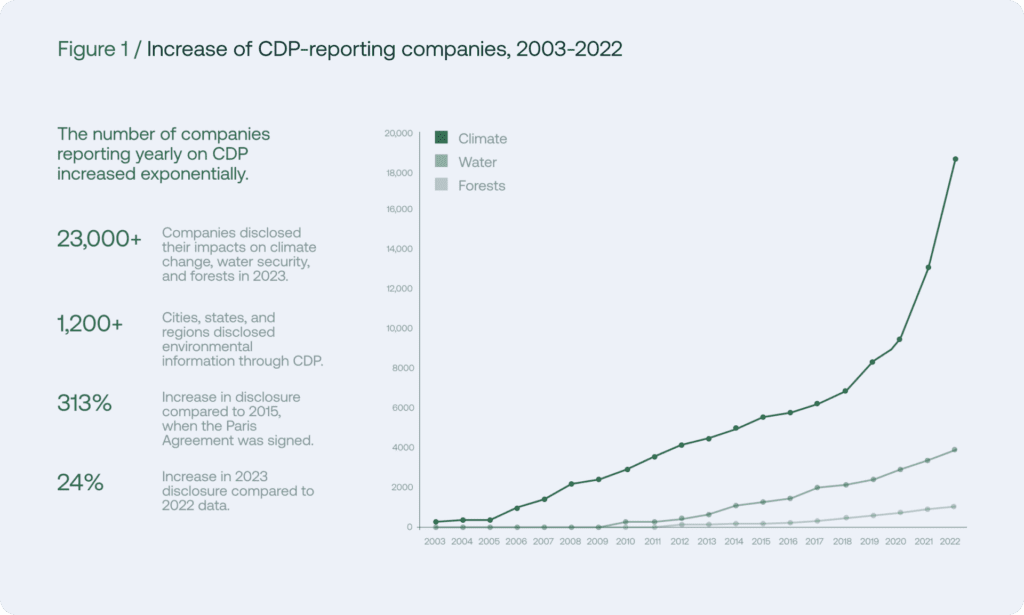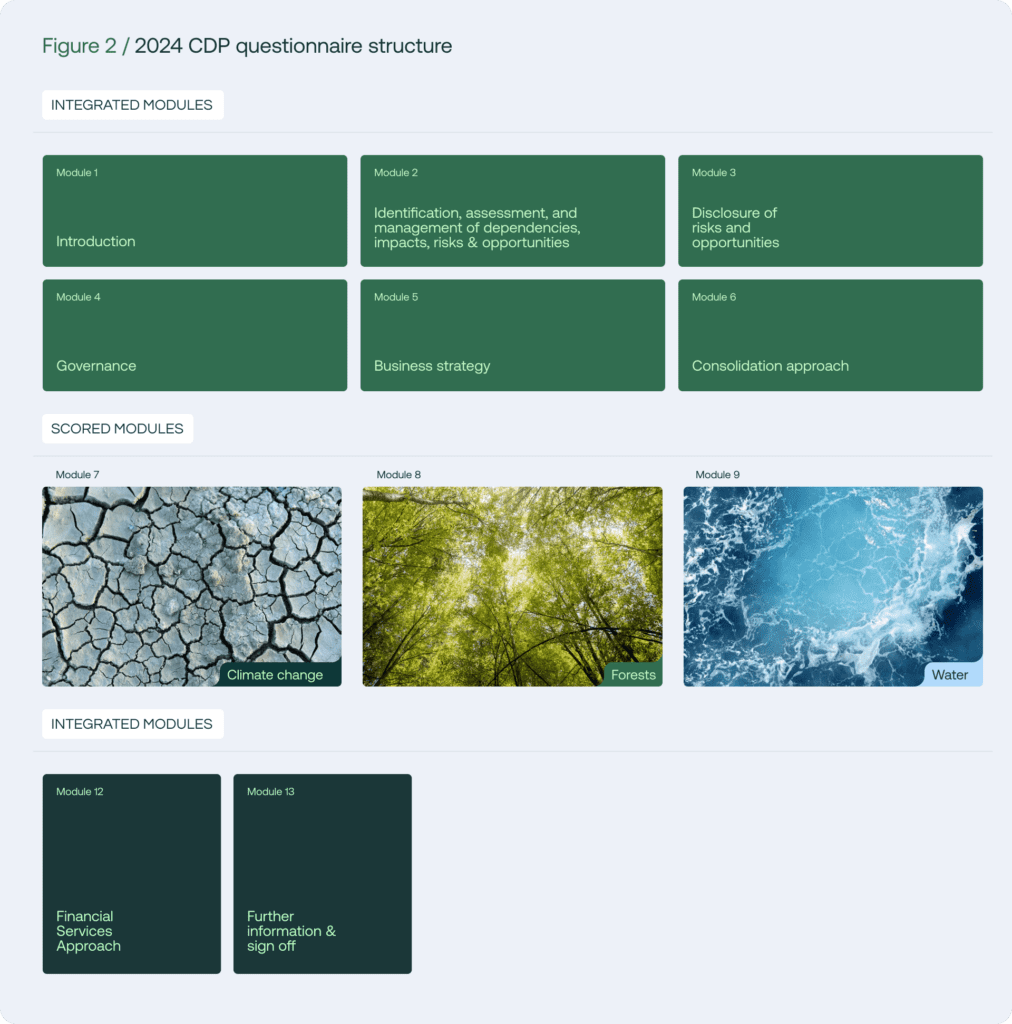



“Disclosure through CDP can help your company navigate contractual requirements and supplier sustainability assessments, as well as attract new sources of funding.”
In June 2024, the new CDP questionnaire, covering climate change, water and forests, opened for submissions. With more than 24,000 organisations disclosing their environmental impacts in 2023, this influential standard continues to grow in scope. The latest iteration of the corporate questionnaire promises to be the most wide-ranging yet, bringing together complex issues such as biodiversity and plastic pollution into one dataset.
But for those preparing for their first disclosure, or unsure about this year’s update, starting the submission process can be daunting. To give you an overview of what to expect, we’ve put together a detailed guide to the CDP assessment. Read on to learn more about this key disclosure system and how it can support your company’s sustainability management strategy.

Formerly known as the Carbon Disclosure Project, CDP is a not-for-profit organisation that aims to facilitate environmental reporting for both companies and other entities such as cities, states and regions.
Its vision? ‘Building a sustainable economy by measuring and acting on environmental impact’. Since its inception in 2000, the organisation has pioneered an approach to environmental reporting that brings together investors and organisations – as well as customers and suppliers – to enable transparent and comprehensive disclosures.
Since its launch in 2000, CDP has continued to grow in popularity. In 2023, 23,000 companies disclosed through CDP, a 24% increase from 2022, and 313% more than when the Paris Agreement was signed in 2015. And more and more organisations are turning to the CDP assessment, considered by many to be the gold standard in climate reporting.
In addition, increasing numbers of investors and customers around the world are requesting environmental data from their business partners.
This year, 75,000 companies have been asked to disclose their environmental impacts through the CDP platform. This reflects a growing awareness of third-party environmental risks in the corporate world, as organisations seek to align with global initiatives such as the Paris Agreement, the Race to Zero campaign and the Science Based Targets initiative.
So, as we look ahead to the new disclosure season, here are the key facts you need to know to get started on your CDP reporting journey.


The business case for sustainability is now well established, with CDP research showing that climate change leaders outperform the market by an average of 5.8% per year. Indeed, a well-integrated sustainability strategy can deliver significant benefits, including operational efficiencies and lower costs. [1]
Meanwhile, according to 86% of companies surveyed by CDP, ‘protecting and improving the reputation of my organisation’ is a key benefit of disclosure. Transparent reporting can therefore help stakeholders make better-informed decisions on whether to work with or buy from your company.
In addition, the majority of companies responding to a 2023 CDP survey said that completing the assessment had enabled them to ‘understand environmental impacts, drive climate action, increase ambition, reduce risk, meet regulatory requirements and implement best practice’
With the introduction of non-financial reporting legislation in the EU and around the world, it’s essential to get ready for increased transparency requirements.
For example, the expanded reporting scope of the Corporate Sustainability Reporting Directive (CSRD) in the EU means that nearly 50,000 companies will be required to report on climate impacts, risks and opportunities. It’s therefore vital to get clarity on your environmental impacts – including emissions reporting and science-based mitigation strategies. [2]
Completing a CDP submission is the ideal way to prepare for mandatory sustainability disclosure, enabling you to implement processes and facilitate data collection.
A major benefit of the CDP methodology is its alignment with a range of sustainability assessment and reporting frameworks.
For example, disclosures completed under the latest CDP standard are also compliant with the International Sustainability Standards Board (ISSB)’s IFRS S2 standard, which covers climate risks and opportunities (find out more here).
In addition, reporting through CDP enables companies to improve their environmental scores in the EcoVadis assessment, the world’s most trusted sustainability rating system (more information here). Other aligned frameworks include GRI, SASB and the Corporate Reporting Dialogue.
Companies including Nike, Airbus, Bank of America, Dell, Unilever, Walmart, Microsoft, Ørsted and Bayer are among those now requesting environmental data from suppliers through CDP.
This highlights the platform’s key role in promoting supply chain transparency, and disclosure through CDP can increase your organisation’s chances of winning business.
In fact, for 63% of companies, CDP environmental data is a potential deciding factor when choosing whether or not to contract a supplier. Disclosure through CDP can therefore help your company navigate contractual requirements and supplier sustainability assessments.
ESG criteria are playing an increasingly important role in investment decisions, and transparent reporting on your company’s environmental impacts can help you stand out.
For example, funds such as the Aviva Climate Transition Global Equities Fund and Amundi’s Climate Action Fund require companies to have a CDP score of B or higher to be included. CDP disclosure is a great way to increase the visibility of your environmental progress to investors and to access new sources of funding. In addition, CDP data is being used by a growing number of agencies – such as Bloomberg, MSCI and Euronext – in their ESG ratings.
Companies are required to submit information through the CDP questionnaire, also known as the online response system (ORS).
From 2024, the full corporate questionnaire combines all the CDP topics – including water, forests, biodiversity and climate change – into one submission.
The questions go into detail about your organisation, covering governance and strategy, targets and performance against different criteria, as well as topic-specific questions such as carbon emissions data. This aims to give a holistic picture of your organisation’s environmental impacts. CDP has also launched a simplified questionnaire with fewer data points specifically for SMEs to help them streamline their sustainability reporting process.


After submitting the questionnaire, the reporting company receives a score that reflects how well it addresses climate-related issues across governance, strategy, risk management, metrics and targets.
As a standardised reporting framework, CDP enables benchmarking between companies in terms of their environmental impact reduction efforts and the transparency of their communications.
CDP bases its scoring entirely on the information submitted through the ORS, awarding a score from D- to A. Evidence assessed is kept confidential, and the assessment does not require documentation to support responses.
A score of F may also be attributed if an organisation fails to provide the required information (i.e. does not respond to a request for disclosure).
If you wish to submit a CDP disclosure, or if a stakeholder has requested your submission, you have until 18 September 2024 to complete the questionnaire on the ORS.
Below are some tips and best practices to help you prepare for the CDP questionnaire.
Are you curious to hear the tips of a first-hand CDP disclosing company? Catch up on our latest panel session.


Whether you’re new to CDP or want to improve on last year’s score, our experts at Nexio Projects can help streamline every stage of your CDP submission – from stakeholder engagement and information gathering to completing the final questionnaire.


[1] See Whelan & Fink (2016), and Porter & Kramer (2011)
[2] Learn more about European sustainability reporting regulations here